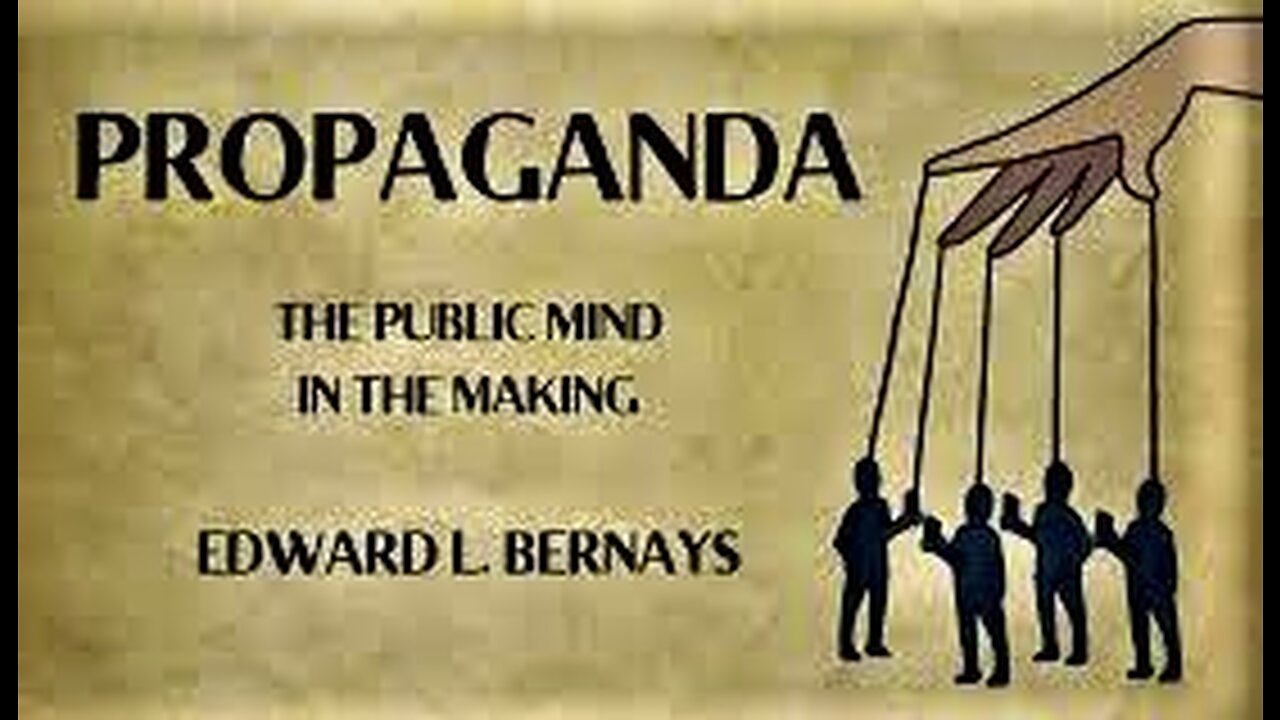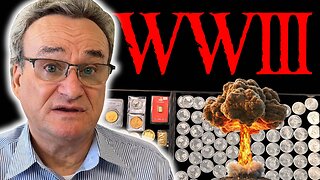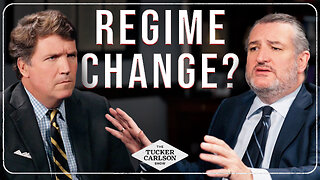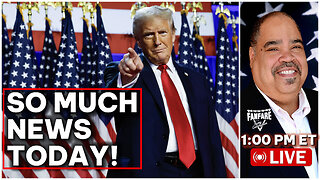Premium Only Content

Edward Bernays and Woodrow Wilson’s WWI
Birth of the Hun: The Propagandists
“Will it be any wonder if, after the war, the people of the world, when they recognize any human being as a German, will shrink aside so that they may not touch him as he passes, or stoop for stones to drive him from their path?” Vernon Kellogg bragged after doing his bit for the war-makers.
By 1917, over forty different peace groups in the U.S.A. were agitating against involvement in the war.
On the day that Wilson called upon Congress to declare war, 10,000 people had a peace rally in Chicago Coliseum, thousands of German-Americans demanded a national referendum and 1,500 pacifists protested in the Capitol. Civil War veteran General Isaac R. Sherwood made a futile appeal to Congress in which he reminded them of England’s attack upon the US during the Civil War.
He warned that the American people would be going to war “as an Ally of the only nation in Europe that has always been our enemy and against the nation that has always been our friend.”
Wilson asked Congress to take up what would become the Espionage Act in his April 2, 1917 address as he asked for a declaration of war against Germany. Wilson and his allies needed to create a “war will” in the public.
It had to become blindly devoted to the federal government, and true “patriotism” would require absolute loyalty to Wilson. Any criticism of either would be treason.
The congressional declaration of war was overwhelming. Amid the flag-waving, cheers and speeches, only six senators and fifty representatives voted against it.
The Senate, however, did strike down Wilson’s request to give him power to restrain the press. He found ways around that obstacle.
Wilson won election as a peace candidate with the slogan “He kept us out of War,” but caved in to the pro-war camp so rapidly that there were rumors he was being blackmailed. In an effort to save face, it was crucial to quickly whip up war fever. He turned to old friend and muckraking journalist George Creel to head a propaganda ministry, the first of its type.
The Center for Public Interest (C.P.I.) was created by executive order one week after the U.S. declaration of war.
In an era when much of the population did not read well (or at all) and there was no radio and television to rely upon for information, the CPI used every weapon available to spread their message to, as Creel would later say, “turn the American people into “one white-hot mass (of hatred) with fraternity, devotion, courage, and deathless determination.” The CPI would soon grow into a massive agency, digging into almost every aspect of daily life and later acting as a censor of almost all published material about the war.
It helped to draft legislation such as the ‘Espionage and Sedition’ Acts which would effectively silence any opposition to the war. Like a secret police agency, it crafted an atmosphere which, in the process of war-mongering, intentionally created suspicion, fear, ethnic hatred and violence by inventing the German arch-villain.
The Creel Committee was not entirely responsible for converting a neutral American public into a hun-hunting mob.
The wheels had already been set in motion by various special interest groups who had a financial stake in the war.
Nicholas Murray Butler’s Carnegie Endowment for International Peace had been whipping up war fever for months and many prominent community and business leaders in the U. S. had been pro-Ally from the start. A “War Sabbath” had already beat the drum for war in some of the nation’s bigger houses of worship at the behest of wealthy donors.
George Creel was the civilian chair of the CPI. Secretaries of State Robert Lansing, of War Newton Baker and of Navy Josephus Daniels topped off the executive committee membership.
The CPI had two sections:
The foreign section, concerned with directing American propaganda activities overseas which established offices in over thirty countries, and the domestic section, which was composed of a mutating variety and size of specialized divisions to mobilize the home front.
At only 5 feet 7 inches tall, CPI general George Creel was a homely, mediocre publicist and Woodrow Wilson’s personal friend.
Creel entertained Wilson, who was said to gleefully clap his hands at Creel’s mimics of old Southerners and uptight Yankees in Congress. A party hack, he went at his new job with zeal. He organized the CPI’s domestic division into nineteen subdivisions, each to target market specific groups of people.
Using sales experts and psychologists, they flooded every possible channel of communication to create war fever using blatantly dishonest messages.
They were given credibility by the recruitment of respected figures such as John Dewey and Walter Lippmann under the wing of the CPI’s ‘Division of Civic and Educational Cooperation.’ This batch of scholars under the directorship of Guy Stanton Ford produced hundreds of publications and such writings as ‘The German Whisper,’ ‘German War Practices’ and ‘Conquest and Kultur.’
The ‘American Alliance for Labor and Democracy’ under Samuel Gompers of the American Federation of Labor eagerly agreed to keep peace in the unions in connection with the war effort, which later translated into government violence against striking workers.
The CPI reached deeply into every available avenue of brain washing with a flock of crafty psychologists under the leadership of Sigmund Freud’s nephew, Edward Bernays.
They went about indoctrinating the public by using well-studied psychological tactics until daily life in America was infused with hate and people were automatically conditioned to disgust and hatred for all things German.
The ‘Division of Pictorial Publicity’ headed by Charles Dana Gibson formed on April 17, 1917 to deal with print media, notably posters, illustrations and ads in magazines and papers in which they received free ad space.
Respected and talented artists such as N.C Wyeth were asked to channel their creative forces into recruiting for a violent and bloody war.
They often produced huge patriotic paintings. James Montgomery Flagg concocted the famous ‘Uncle Sam.’ George Bellows also contributed to the inexhaustible effort to convince citizens that Germany threatened to impose what he termed its “barbaric and blood thirsty Kultur” upon innocent Americans.
‘The Four Minute Men,’ another tentacle of the CPI, managed 75,000 volunteer speakers in 5,200 communities.
An amateur orators would speak wherever they could, even in churches. Over 7.5 million speeches provoking hate, fear and suspicion toward Germany and Germans were delivered to more than 314 million people, thousands having such dreadful impact that mobs sometimes formed afterward and vandalized German-American homes and businesses.
Using subliminal messaging rivaling that of today’s retail giants, the Four Minute Men also hired bi-lingual speakers to target specific immigrant groups, businessmen to gather support of other businessmen, farmers to sell the war to farmers and children to spread the hate to other children.
The CPI worked in conjunction with the Food Bureau and formed strong allegiances with editors of women’s magazines, most notably Ladies Home Journal’s editor Edward Bok, a loyal Wilson supporter.
The patriotic and sentimental covers of The Journal enveloped ads, posters and sappy articles extolling sacrifice, thrift and an eagerness to send sons to war. Every issue of The Journal published at least one article specifically written by the staff of the CPI.
The Four Minute Men created a womens division to speak at womens groups and matinees to counteract any notions of war resistance, such as those displayed in the popular pre-war song “I Didn’t Raise My Boy to Be a Soldier.” Bok’s views of women mirrored the CPI’s and shared the same goal: discrediting women reformers and portraying them as dupes of German propaganda.
Some female pacifists eventually suffered violence as a result. The Saturday Evening Post, another of America’s biggest magazines announced that it was time to rid America of Germans, “the scum of the melting pot.”
American women were not told how badly living conditions within Germany had deteriorated since 1915 when the lethal British embargo caused a decline in food supplies.
The diet in Germany, initially reduced to bread and potatoes, turned to turnips as a staple in 1916 when the potato crop failed.
Only the very young or old, invalids or expectant mothers were permitted milk. 88,232 Germans starved to death in 1915, and 121,114 in 1916, and he toll kept growing.
The propagandists had no shame when it came to using children as a vehicle to spread their message, and the CPI psychologists did their work well:
children in America were scared to death of the Hun
In fact, children were organized as “Four Minute Men” speakers in their schools! In 1918, 200,000 schools participated in a spring competition to promote the Third Liberty Loan drive.
The “Division of Civic and Educational Cooperation” published a bi-monthly bulletin promoting “patriotism.”
L to R: The maniacal baby killing Hun; Creel, Gomphers, Bernays, Berlin
The Hun Gonna Steal Yer Farm!
I Didn’t Raise my Son to be a Soldier
British Propaganda
War propaganda movies
Our “impartial” Observers
Britain’s “impartial” Observers
The fact that the British had cut the direct subterranean cables linking Germany with the USA. coupled with the British blockade of Germany made the distribution of German news and books difficult.
American newspapers became almost completely dependent on British sources for war news and Britain had been sending crates full of pro-war pamphlets and books to public libraries across America.
This allowed the CPI to form a choke hold on the public library system and they fostered the idea that it was a librarian’s duty to protect their patrons from possibly “disloyal” material. Few objected.
The American public library in this era was very mush a middle to upper class institution and run more like a private club catering to a constituency mainly of white, professionals and businessmen.
Especially when their biggest benefactors and patrons had a financial stake in Allied victory, librarians willingly became purveyors of propaganda.
Donated books seen as “pro-German” or pacifistic were discarded and replaced with the Creel Committee’s pamphlets wherein well-respected history professors rewrote and grossly distorted German history.
The directors of libraries across the nation were “using their judgement” to purge the shelves of German books, including works by Goethe and other German cultural icons.
The libraries were also used by the CPI to distribute Americanization Registration Cards to thousands of immigrants to be returned with signatures to the CPI’s ‘Division of Work with the Foreign Born.’ The libraries in the bigger cities also sponsored “story hours” to thousands of children on the Allied struggle using pro-war CPI material.
The Free Library of Philadelphia, for instance, reported that for the last half of 1917 it had provided 918 story hours to 56, 912 children on the topic of “stories of our allies.” Libraries staged publicity stunts: setting up actress Theda Bara in a Liberty Bond booth in front of the New York Public Library garnered $300,000 in one day. Other CPI war expositions featured acts with traveling “French officers” who told grim German atrocity stories.
Realizing that a good many Americans read the comics and not the rest of a newspaper, the CPI established a Bureau of Cartoons under George Hecht to “mobilize and direct the scattered cartoon power of the country for constructive war work.”
Pro-war, Anti-German propaganda was planted in cartoon pages and supplements across the nation by the closely supervised doodling purveyors of hate. The “funnies” portrayed fat, traitorous German Americans waving a US flag out the window while drinking a stein of beer to “Hoch der Kaiser.” The lewd, greedy, violent “Germans” now sprouted snouts, tusks, hairy faces, red eyes and fangs and were ravaging maidens and killing babies.
America’s media found that the gorier and more sensational the stories, the more magazines and newspapers they sold. In a typical CPI book, ‘Why America Fights Germany,’ Germans penetrate into America and advance toward Lakewood, New Jersey, where they demand beer and money (and maybe even sausage!) and hang a feeble old woman who tries to hide her paltry 20 dollar savings.
The town’s maiden school teachers meet an even worse fate at the hands of the Huns, predators of virtue that they were, and a Catholic priest and Methodist minister are thrown into a pig-sty while the German soldiers laugh.
50 leading citizens are then lined up and shot.
The dirty, sexed-up, gorilla faced “Germans” then burn the lovely town and move on to maraud another.
One of the CPI’s 19 domestic divisions centered its efforts on music and hired thousands of song writers. Government composers were identified only as “Army Song Leaders.” Most tried to portray an ethnically diverse United States (which racially segregated its own troops) railing against the arrogant, haughty “German Race.”
They infused the music with anti-German lyrics and imagery, coupling grotesque looking Germans with pro-war messages printed on sheet music.
There were over a hundred anti-Kaiser songs produced by Tin Pan Alley such as the cheerful ditty “We Are Out for the Scalp of Mister Kaiser.”
The very day after Wilson’s declaration of war against Germany on April 16, 1917, George M. Cohan was ready with “Over There,” one of the most successful American propaganda songs for which Cohan was later given a special Congressional Medal of Honor.
Irving Berlin played a huge role in the pro-war propaganda.
Even John Philip Sousa provided patriotic inspiration with his music (often lifted from German songs and marches) at Liberty Loan rallies and Red Cross relief drives.
German language publication in the USA now faced large-scale assaults. The Atlantic Monthly accused the German language press of disloyalty and the New York Times agreed, relentlessly claiming that German-language newspapers slyly supported Berlin’s cause.
The Times, claiming that “any book that comes to us from a German printing press is open to suspicion,” suspended all publications from Germany because “the German microbe is hiding somewhere between its covers.”
Publisher Irving Putnam vowed:
“I am opposed to opening the markets of America to the products of Germany for the next 25 years, and I will knowingly buy and use no German-made goods in the said period of time.”
In September, 1917, Congress sneaked in a rider to an unrelated bill which gave the government even greater control over the expression of opinion among German-Americans and Wilson signed it on October 6th. German-language newspapers were now required to supply the post office with English translations of “any comments respecting the Government of the United States... its policies, international relations or the state and conduct of the war.”
One of the worst abusers of the public right to privacy was Postmaster General Albert Burleson who abused his wide discretionary powers in denying many socialist, pacifist, and anti-war publications access to the U.S. mail.
By the end of 1917, the CPI was sending every newspaper in California alone an average of six pounds of propaganda paper a day and gushing out over 20,000 columns a week.
Second rate artists, authors and journalists now had a change for instant fame (or at least a paying job) with sensational atrocity stories. John R. Rathom wrote articles and spy stories in the Providence Journal which were so sensational it was said that he was coached by the British Secret Service.
He also gave numerous lectures and in 1917/18 he led a campaign against “German sympathizers” and exposed German spy plots in America.
In 1918, there were suspicions that his articles were fakes and by 1920 he was accused of circulating falsehoods, which he reluctantly admitted.
He was finally discredited, but not until after “Rathomania” had achieved considerable success in molding the public mind.
Other media lies circulated in 1918 included: German airplanes dropping poisoned candy for kids, Germans raping Belgian nuns, cutting off the enemy’s ears and feeding Americans tuberculosis germs. In St. Louis, Missouri, newspapers reported that the Germans gave children hand-grenades to play with and then frolicked in glee when the grenades exploded and blew up the kids. Several patriotic newspapers began printing black lists of local German-Americans (including their addresses) which were headlined “German Enemy Aliens.”
Despite even General Pershing and the US War Department absolutely debunking the absurd atrocity fabrications, many of these same stories were introduced as the basis of war propaganda movies that had the blessing of Wilson himself:
The CPI’s Films Division itself produced over sixty official feature films delivered to an average weekly movie audience of 80 million people, ending the day at the movies with its weekly newsreel the ‘Official War Review.’
In just a few short months, the age old, generally good public image of the German people would be completely turned on its head by thousands of propagandists working tirelessly from both sides of the ocean at this carefully structured diabolical task.
How Woodrow Wilson’s Propaganda Machine Changed American Journalism
The media are still feeling the impact of an executive order signed in 1917 that created ‘the nation’s first ministry of information’
When the United States declared war on Germany 100 years ago, the impact on the news business was swift and dramatic.
How WW I helped entrench the art of mass persuasion
Modern marketing and PR got its big start in a broken campaign promise made nearly 100 years ago
President Woodrow Wilson delivers a speech to the joint session of Congress in Washington on April 2, 1917.
Wilson had been re-elected in November 1916 on the slogan “he kept us out of war,” but had a change of heart and authorized the creation of the Committee on Public Information to fire up a reluctant American population
Corporations spend billions each year trying to influence how people think, act and spend. But the fields of modern public relations and product marketing really aren't all that new – they got their big start in a broken campaign promise made nearly 100 years ago.
And as broken campaign promises go, this was one of the biggest.
In April 1917, the First World War had been raging for almost three years, but the United States had remained outside the fray.
Although supportive of the Allied Powers, President Woodrow Wilson urged Americans to be neutral in thought and action. Public opinion in the U.S. was solidly behind him - Wilson had been re-elected in November 1916 on the slogan "he kept us out of war."
Five months later, the president had a change of heart.
Germany was continuing to harass American shipping, and there were real concerns in Washington that the war would be lost. So on April 6, Wilson was able to persuade Congress to declare war on the Central Powers.
Persuading Americans to support the war would be a more challenging task.
Committee on Public Information
Within days of the declaration, the president authorized the creation of the Committee on Public Information.
Under the leadership of George Creel, a former muckraking journalist, the CPI was tasked with winning the war at home by firing up a reluctant American population into what Creel called "the white hot mass of patriotism," and spreading the good news about America and its democratic values throughout the world.
The famous World War One "Uncle Sam" recruitment poster was painted by James Montgomery Flagg for the Committee on Public Information. (Reuters)
The CPI brought together many of the brightest minds in advertising, journalism, graphic design, academia, and a relatively new industry called public relations.
By the end of the war, more than 100,000 Americans had contributed to the CPI's efforts. They created Uncle Sam and other iconic recruiting images. They churned out millions of press releases, bulletins, photographs and posters, and produced silent movies with names like Pershing's Crusaders and America's Answer.
And 75,000 local notables, known as Four Minute Men, signed up to deliver carefully crafted four minute inspirational orations in church halls, movie theatres, and anywhere else that Americans gathered.
It all worked spectacularly well.
Within months, Americans had shed their initial war reluctance.
Young men were flocking to recruiting offices, and millions were giving money to support the "Liberty Loan" program to help finance the war effort.
The success of the CPI opened the eyes of many of its publicists to new techniques of mass persuasion, and brought the fledgling public relations industry from the fringes of American commerce into the mainstream.
Heart vs. head
"Our effort was educational and informative throughout," George Creel insisted after the war.
In fact, it was anything but.
The CPI was the largest propaganda machine the world had ever seen. And while its title stressed "information," the Committee's publicists understood that electrifying American public opinion would take an appeal to the emotions, not the intellect.
The CPI's Division of Advertising churned out posters and ads that depicted German atrocities that never happened, played up threats to American homes and families that were wildly exaggerated, and generally appealed to the fears and anxieties that lurked beneath the surface of public consciousness.
All of this was observed with great interest by a young member of the CPI team named Edward Bernays.
In this Sept. 26, 1918 photo, a U.S .Army 37mm gun crew man their position during the World War One Meuse-Argonne Allied offensive in France.
The CPI’s Division of Advertising churned out propaganda to bolster the support of Americans at home for the war effort. (The Associated Press)
When the war broke out, Bernays was hired to write propaganda for the CPI's Latin American section. He was a 26-year-old publicist based in New York City, and he had very big ambitions.
Bernays was the nephew of Sigmund Freud and he shared his uncle's fascination with the unconscious mind.
But while Freud sought to liberate people from their subconscious drives and desires, Bernays wanted to harness those passions for commercial ends.
His work with the CPI had convinced him that if you could sell war by appealing to images and symbols, then you could do the same thing to sell just about anything.
"I decided that if you could use propaganda for war, you could certainly use it for peace," he told a BBC interviewer in the early 1990s.
Bernays had concluded that public opinion was fundamentally irrational, and irrationality was now the filter through which human nature could best be understood.
Symbols, not facts, would be the primary tool of persuasion. Public opinion was to be manufactured and managed through communications strategies that aimed for the gut rather than the brain.
Torches of Freedom
Bernays returned to New York after the war and set himself up as a "counsel on public relations," determined to put his theories into action.
One of his earliest successes was for the American Tobacco Company. It had hired Bernays to figure out a way to get American women to feel comfortable about smoking in public.
After consulting a colleague of his uncle's, Bernays concluded that women needed to see cigarettes as "torches of freedom" that would help emancipate them from the social taboos imposed on them by men.
He arranged for several young women to walk down 5th Ave. in New York during the Easter parade, smoking.
As Bernays expected, the story made front page news across the country, and the rest, unfortunately, is history.
Regimenting the public mind
Bernays, who died in 1995 at the age of 103, is widely regarded as one of the founding fathers of modern public relations.
Writing 10 years after the war, Bernays noted that World War One had, 'opened the eyes of the intelligent few in all departments of life to the possibilities of regimenting the public mind.'
For good and ill, the influence of Bernays can be felt throughout the world of public relations today.
He was among the first to do research into what consumers actually want, one of the first to understand the value of "expert" testimonials in advertising, and to capitalize on the power of "front groups" that allow organizations to anonymously advocate for their causes.
Throughout his life, he insisted that the "astounding success" of the CPI's propaganda was the key to the evolution of public relations.
Writing 10 years after the war, Bernays noted that the First World War had "opened the eyes of the intelligent few in all departments of life to the possibilities of regimenting the public mind."
They had seen public opinion moulded in ways they had not previously imagined. They had learned the power of images and symbols, they had begun to explore the subconscious triggers that could activate public passions.
These were lessons they didn't soon forget when the shooting stopped.
In its crusade to “make the world safe for democracy,” the Wilson administration took immediate steps at home to curtail one of the pillars of democracy – press freedom – by implementing a plan to control, manipulate and censor all news coverage, on a scale never seen in U.S. history.
Following the lead of the Germans and British, Wilson elevated propaganda and censorship to strategic elements of all-out war. Even before the U.S. entered the war, Wilson had expressed the expectation that his fellow Americans would show what he considered “loyalty.”
Immediately upon entering the war, the Wilson administration brought the most modern management techniques to bear in the area of government-press relations.
Wilson started one of the earliest uses of government propaganda. He waged a campaign of intimidation and outright suppression against those ethnic and socialist papers that continued to oppose the war. Taken together, these wartime measures added up to an unprecedented assault on press freedom.
I study the history of American journalism, but before I started researching this episode, I had thought that the government’s efforts to control the press began with President Roosevelt during WWII.
Wilson was the pioneer of a system that persists to this day
All Americans have a stake in getting the truth in wartime. A warning from the WWI era, widely attributed to Sen. Hiram Johnson, puts the issue starkly: “The first casualty when war comes is truth.”
Mobilizing for war
Within a week of Congress declaring war, on April 13, 1917, Wilson issued an executive order creating a new federal agency that would put the government in the business of actively shaping press coverage.
That agency was the Committee on Public Information, which would take on the task of explaining to millions of young men being drafted into military service – and to the millions of other Americans who had so recently supported neutrality – why they should now support war.
The new agency – which journalist Stephen Ponder called “the nation’s first ministry of information” – was usually referred to as the Creel Committee for its chairman, George Creel, who had been a journalist before the war. From the start, the CPI was “a veritable magnet” for political progressives of all stripes – intellectuals, muckrakers, even some socialists – all sharing a sense of the threat to democracy posed by German militarism.
Idealistic journalists like S.S. McClure and Ida Tarbell signed on, joining others who shared their belief in Wilson’s crusade to make the world safe for democracy.
At the time, most Americans got their news through newspapers, which were flourishing in the years just before the rise of radio and the invention of the weekly news magazine.
In New York City, according to my research, nearly two dozen papers were published every day – in English alone – while dozens of weeklies served ethnic audiences.
Starting from scratch, Creel organized the CPI into several divisions using the full array of communications.
The Speaking Division recruited 75,000 specialists who became known as “Four-Minute Men” for their ability to lay out Wilson’s war aims in short speeches.
The Film Division produced newsreels intended to rally support by showing images in movie theaters that emphasized the heroism of the Allies and the barbarism of the Germans.
The Foreign Language Newspaper Division kept an eye on the hundreds of weekly and daily U.S. newspapers published in languages other than English.
uncle sam
Another CPI unit secured free advertising space in American publications to promote campaigns aimed at selling war bonds, recruiting new soldiers, stimulating patriotism and reinforcing the message that the nation was involved in a great crusade against a bloodthirsty, antidemocratic enemy.
Some of the advertising showed off the work of another CPI unit
The Division of Pictorial Publicity was led by a group of volunteer artists and illustrators. Their output included some of the most enduring images of this period, including the portrait by James Montgomery Flagg of a vigorous Uncle Sam, declaring, “I WANT YOU FOR THE U.S. ARMY!”
**********
Other ads showed cruel “Huns” with blood dripping from their pointed teeth, hinting that Germans were guilty of bestial attacks on defenseless women and children. “Such a civilization is not fit to live,” one ad concluded.
Liberty bonds
Creel denied that his committee’s work amounted to propaganda, but he acknowledged that he was engaged in a battle of perceptions. “The war was not fought in France alone,” he wrote in 1920, after it was all over, describing the CPI as “a plain publicity proposition, a vast enterprise in salesmanship, the world’s greatest adventure in advertising.”
Buried in paper
For most journalists, the bulk of their contact with the CPI was through its News Division, which became a veritable engine of propaganda on a par with similar government operations in Germany and England but of a sort previously unknown in the United States.
In the brief year and a half of its existence, the CPI’s News Division set out to shape the coverage of the war in U.S. newspapers and magazines.
One technique was to bury journalists in paper, creating and distributing some 6,000 press releases – or, on average, handing out more than 10 a day.
The whole operation took advantage of a fact of journalistic life. In times of war, readers hunger for news and newspapers attempt to meet that demand. But at the same time, the government was taking other steps to restrict reporters’ access to soldiers, generals, munitions-makers and others involved in the struggle. So, after stimulating the demand for news while artificially restraining the supply, the government stepped into the resulting vacuum and provided a vast number of official stories that looked like news.
Most editors found the supply irresistible. These government-written offerings appeared in at least 20,000 newspaper columns each week, by one estimate, at a cost to taxpayers of only US$76,000.
In addition, the CPI issued a set of voluntary “guidelines” for U.S. newspapers, to help those patriotic editors who wanted to support the war effort (with the implication that those editors who did not follow the guidelines were less patriotic than those who did).
The CPI News Division then went a step further, creating something new in the American experience: a daily newspaper published by the government itself. Unlike the “partisan press” of the 19th century, the Wilson-era Official Bulletin was entirely a governmental publication, sent out each day and posted in every military installation and post office as well as in many other government offices. In some respects, it is the closest the United States has come to a paper like the Soviet Union’s Pravda or China’s People’s Daily.
The CPI was, in short, a vast effort in propaganda. The committee built upon the pioneering efforts of public relations man Ivy Lee and others, developing the young field of public relations to new heights.
The CPI hired a sizable fraction of all the Americans who had any experience in this new field, and it trained many more.
One of the young recruits was Edward L. Bernays, a nephew of Sigmund Freud and a pioneer in theorizing about human thoughts and emotions.
Bernays volunteered for the CPI and threw himself into the work. His outlook – a mixture of idealism about the cause of spreading democracy and cynicism about the methods involved – was typical of many at the agency.
“The conscious and intelligent manipulation of the organized habits and opinions of the masses is an important element in democratic society,” Bernays wrote a few years after the war. “Propaganda is the executive arm of the invisible government.”
All in all, the CPI proved quite effective in using advertising and PR to instill nationalistic feelings in Americans. Indeed, many veterans of the CPI’s campaign of persuasion went into careers in advertising during the 1920s.
The full bundle of techniques pioneered by Wilson during the Great War were updated and used by later presidents when they sent U.S. forces into battle.
https://www.prmuseum.org/pioneer-edward-bernays
Pioneer — Edward Bernays - The Museum of Public Relations
https://www.youtube.com/watch?v=zZPwxyZCo9M
The Roots of the Modern Government Propaganda Machine
Oct 14, 2020 ... Woodrow Wilson and the Birth of American Propaganda (LSU Press, 2020), exploring the Great War origins of one of the most profound and ...
To my surprise and delight I was invited over to the Peace Conference in Paris which Woodrow Wilson was to come to and this is a picture of the various ...
The Committee on Public Information (1917–1919), also known as the CPI or the Creel Committee, was an independent agency of the government of the United States under the Wilson administration created to influence public opinion to support the US in World War I, in particular, the US home front.
In just over 26 months (from April 14, 1917, to June 30, 1919) it used every medium available to create enthusiasm for the war effort and to enlist public support against the foreign and perceived domestic attempts to stop America's participation in the war. It is a notable example of propaganda in the United States.
Organizational history
"U.S. Official War Pictures", CPI poster by Louis D. Fancher
Establishment
President Woodrow Wilson (the 28th president) established the Committee on Public Information (CPI) through Executive Order 2594 on April 13, 1917.[1] The committee consisted of George Creel (chairman) and as ex officio members the Secretaries of: State (Robert Lansing), War (Newton D. Baker), and the Navy (Josephus Daniels).[2] The CPI was the first state bureau covering propaganda in the history of the United States.[3]
Creel urged Wilson to create a government agency to coordinate "not propaganda as the Germans defined it, but propaganda in the true sense of the word, meaning the 'propagation of faith.'"[4] He was a journalist with years of experience on the Denver Post and the Rocky Mountain News before accepting Wilson's appointment to the CPI. He had a contentious relationship with Secretary Lansing.[5]
Activities
Wilson established the first modern propaganda office, the Committee on Public Information (CPI), headed by George Creel.[6][7] Creel set out to systematically reach every person in the United States multiple times with patriotic information about how the individual could contribute to the war effort. It also worked with the post office to censor seditious counter-propaganda.
Creel set up divisions in his new agency to produce and distribute innumerable copies of pamphlets, newspaper releases, magazine advertisements, films, school campaigns, and the speeches of the Four Minute Men.
CPI created colorful posters that appeared in every store window, catching the attention of the passersby for a few seconds.[8] Movie theaters were widely attended, and the CPI trained thousands of volunteer speakers to make patriotic appeals during the four-minute breaks needed to change reels.
They also spoke at churches, lodges, fraternal organizations, labor unions, and even logging camps. Speeches were mostly in English, but ethnic groups were reached in their own languages.
Creel boasted that in 18 months his 75,000 volunteers delivered over 7.5 million four minute orations to over 300 million listeners, in a nation of 103 million people.
The speakers attended training sessions through local universities, and were given pamphlets and speaking tips on a wide variety of topics, such as buying Liberty Bonds, registering for the draft, rationing food, recruiting unskilled workers for munitions jobs, and supporting Red Cross programs.[9]
Historians were assigned to write pamphlets and in-depth histories of the causes of the European war.[10][11]
The CPI used material that was based on fact, but spun it to present an upbeat picture of the American war effort. In his memoirs, Creel claimed that the CPI routinely denied false or undocumented atrocity reports, fighting the crude propaganda efforts of "patriotic organizations" like the National Security League and the American Defense Society that preferred "general thundering" and wanted the CPI to "preach a gospel of hate."[12]
The committee used newsprint, posters, radio, telegraph, and movies to broadcast its message. It recruited about 75,000 "Four Minute Men," volunteers who spoke about the war at social events for an ideal length of four minutes.
They covered the draft, rationing, war bond drives, victory gardens and why America was fighting.
They were advised to keep their message positive, always use their own words and avoid "hymns of hate."[13] For ten days in May 1917, the Four Minute Men were expected to promote "Universal Service by Selective Draft" in advance of national draft registration on June 5, 1917.[14]
The CPI staged events designed for many different ethnic groups, in their language. For instance, Irish-American tenor John McCormack sang at Mount Vernon before an audience representing Irish-American organizations.[15]
The committee also targeted the American worker and, endorsed by Samuel Gompers, filled factories and offices with posters designed to promote the critical role of American labor in the success of the war effort.[16]
As the war progressed, the depiction of the enemy evolved in CPI publications. Initially in 1917, CPI pamphlets emphasized the importance of defending democracy and liberty from the German state.
Over time the distinction between the German state and the German people was blurred. By 1918, following German military advances, pamphlets depicted individuals of German descent living in the United States as a threat.[17]
The CPI's activities were so thorough that historians later stated, using the example of a typical midwestern American farm family, that[18]
Every item of war news they saw—in the country weekly, in magazines, or in the city daily picked up occasionally in the general store—was not merely officially approved information but precisely the same kind that millions of their fellow citizens were getting at the same moment. Every war story had been censored somewhere along the line— at the source, in transit, or in the newspaper offices in accordance with ‘voluntary’ rules established by the CPI.
Creel wrote about the committee's rejection of the word propaganda, saying:
"We did not call it propaganda, for that word, in German hands, had come to be associated with deceit and corruption. Our effort was educational and informative throughout, for we had such confidence in our case as to feel that no other argument was needed than the simple, straightforward presentation of facts."[19]
A report published in 1940 by the Council on Foreign Relations credits the committee with creating "the most efficient engine of war propaganda which the world had ever seen", producing a "revolutionary change" in public attitude toward US participation in WWI:[20]
In November 1916, the slogan of Wilson's supporters, 'He Kept Us Out Of War,' played an important part in winning the election. At that time a large part of the country was apathetic.... Yet, within a very short period after America had joined the belligerents, the nation appeared to be enthusiastically and overwhelmingly convinced of the justice of the cause of the Allies, and unanimously determined to help them win.
The revolutionary change is only partly explainable by a sudden explosion of latent anti-German sentiment detonated by the declaration of war.
Far more significance is to be attributed to the work of the group of zealous amateur propagandists, organized under Mr. George Creel in the Committee on Public Information.
With his associates he planned and carried out what was perhaps the most effective job of large-scale war propaganda which the world had ever witnessed.
Organizational structure
During its lifetime, the organization had over twenty bureaus and divisions, with commissioner's offices in nine foreign countries.[21]
Both a News Division and a Films Division were established to help get out the war message. The CPI's daily newspaper, called the Official Bulletin, began at eight pages and grew to 32.
It was distributed to every newspaper, post office, government office, and military base.[22] Stories were designed to report positive news. For example, the CPI promoted an image of well-equipped US troops preparing to face the Germans that were belied by the conditions visiting Congressmen reported.[23] The CPI released three feature-length films:
Pershing's Crusaders (May 1918), America's Answer (to the Hun) (August 1918), Under Four Flags (November 1918). They were unsophisticated attempts to impress the viewer with snippets of footage from the front, far less sensational than the "crudely fantastical" output of Hollywood in the same period.[24]
To reach those Americans who might not read newspapers, attend meetings or watch movies, Creel created the Division of Pictorial Publicity.[25]
The Division produced 1438 designs for propaganda posters, cards buttons and cartoons in addition to 20000 lantern pictures (slides) to be used with the speeches.[26] Charles Dana Gibson was America's most popular illustrator – and an ardent supporter of the war.
When Creel asked him to assemble a group of artists to help design posters for the government, Gibson was more than eager to help.
Famous illustrators such as James Montgomery Flagg, Joseph Pennell, Louis D. Fancher, and N. C. Wyeth were brought together to produce some of World War I's most lasting images.
Media incidents
One early incident demonstrated the dangers of embroidering the truth.
The CPI fed newspapers the story that ships escorting the First Division to Europe sank several German submarines, a story discredited when newsmen interviewed the ships' officers in England.
Republican Senator Boies Penrose of Pennsylvania called for an investigation and The New York Times called the CPI "the Committee on Public Misinformation."[27]
The incident turned the once compliant news publishing industry into skeptics.[28]
There is some confusion as to whether or not the claims are correct based upon subsequent information published by the CPI.[29]
Early in 1918, the CPI made a premature announcement that "the first American built battle planes are today en route to the front in France," but newspapers learned that the accompanying pictures were fake, there was only one plane, and it was still being tested.[30]
At other times, though the CPI could control in large measure what newspapers printed, its exaggerations were challenged and mocked in Congressional hearings.[31]
The committee's overall tone also changed with time, shifting from its original belief in the power of facts to mobilization based on hate, like the slogan "Stop the Hun!" on posters showing a US soldier taking hold of a German soldier in the act of terrorizing a mother and child, all in support of war bond sales.[32]
International efforts
The CPI extended its efforts overseas as well and found it had to tailor its work to its audience. In Latin America, its efforts were led where possible by American journalists with experience in the region, because, said one organizer, "it is essentially a newspaperman's job" with the principal aim of keeping the public "informed about war aims and activities." The Committee found the public bored with the battle pictures and stories of heroism supplied for years by the competing European powers. In Peru it found there was an audience for photos of shipyards and steel mills.
In Chile it fielded requests for information about America's approach to public health, forest protection, and urban policing. In some countries it provided reading rooms and language education.
Twenty Mexican journalists were taken on a tour of the United States.[33]
Political conflict
Creel used his overseas operations as a way to gain favor with congressmen who controlled the CPI's funding, sending friends of congressmen on brief assignments to Europe.[34]
Some of his business arrangements drew congressional criticism as well, particularly his sale by competitive bidding of the sole right to distribute battlefield pictures.[35]
Despite hearings to air grievances against the CPI, the investigating committee passed its appropriation unanimously.[36]
Creel also used the CPI's ties to the newspaper publishing industry to trace the source of negative stories about Secretary of the Navy Josephus Daniels, a former newsman and a political ally. He tracked them to Louis Howe, assistant to Assistant Secretary of the Navy Franklin D. Roosevelt and threatened to expose him to the President.[37]
As a Wilson partisan, Creel showed little respect for his congressional critics, and Wilson enjoyed how Creel expressed sentiments the President could not express himself.[38][39]
Termination and disestablishment
Committee work was curtailed after July 1, 1918. Domestic activities stopped after the Armistice was signed on November 11, 1918. Foreign operations ended June 30, 1919.
Wilson abolished the CPI by executive order 3154 on August 21, 1919.
The Committee on Public Information was formally disestablished by an act of Congress on June 30, 1919, although the organization's work had been formally completed months before.[40]
On August 21, 1919, the disbanded organization's records were turned over to the Council of National Defense.[40]
Memoirs
Creel later published his memoirs of his service with the CPI, How We Advertised America, in which he wrote:[19]
In no degree was the Committee an agency of censorship, a machinery of concealment or repression. Its emphasis throughout was on the open and the positive.
At no point did it seek or exercise authorities under those war laws that limited the freedom of speech and press. In all things, from first to last, without halt or change, it was a plain publicity proposition, a vast enterprise in salesmanship, the world's greatest adventures in advertising.... We did not call it propaganda, for that word, in German hands, had come to be associated with deceit and corruption.
Our effort was educational and informative throughout, for we had such confidence in our case as to feel that no other argument was needed than the simple, straightforward presentation of the facts.
Criticism
Chris Hedges, Pulitzer Prize-winning journalist, provides a detailed critique of the Creel Commission in his 2010 book Death of the Liberal Class.
He describes the CPI’s work as “a relentless campaign of manipulation of public opinion thinly disguised as journalism,” including manufactured German atrocities and war crimes. [41]
Walter Lippmann, a Wilson adviser, journalist, and co-founder of The New Republic, who was influential with Wilson in his advocacy for the establishment of a pro-war propaganda committee in 1917, may have later been a critic of Creel. [42]
He had once written an editorial criticizing Creel for violating civil liberties, as Police Commissioner of Denver. Without naming Creel, he wrote in a memo to Wilson that censorship should "never be entrusted to anyone who is not himself tolerant, nor to anyone who is unacquainted with the long record of folly which is the history of suppression." After the war, Lippmann criticized the CPI's work in Europe: "The general tone of it was one of unmitigated brag accompanied by unmitigated gullibility, giving shell-shocked Europe to understand that a rich bumpkin had come to town with his pockets bulging and no desire except to please."[43]
The Office of Censorship in World War II did not follow the CPI precedent. It used a system of voluntary co-operation with a code of conduct, and it did not disseminate government propaganda.[18]
Staff
Among those who participated in the CPI's work were:
Edward Bernays, a pioneer in public relations and later theorist of the importance of propaganda to democratic governance.[44]
He directed the CPI's Latin News Service.
The CPI's poor reputation prevented Bernays from handling American publicity at the 1919 Peace Conference as he wanted.[45]
Carl R. Byoir (1886 – 1957), like Bernays, a founding father of public relations in America.
Maurice Lyons was the Secretary of the committee. Lyons was a journalist who got involved in politics when he became secretary to William F. McCombs, who was Chairman of the Democratic National Committee during Woodrow Wilson's presidential campaign of 1912.
Charles Edward Merriam, a professor of political science at the University of Chicago and an adviser to several US Presidents.
Ernest Poole. Poole was the co Director of the Foreign Press Bureau division. Poole was awarded the very first Pulitzer Prize for Fiction for his novel, His Family.
Dennis J. Sullivan, Manager of Domestic Distribution for films made by the CPI.[46]
Vira Boarman Whitehouse, director of the CPI's office in Switzerland.
She repeatedly crossed into Germany to deliver propaganda materials. She later told of her experiences in A Year as a Government Agent (1920)
The Tavistock Institute of Human Relations — Dr. John Coleman's book
The authoritative expose of the greatest brainwashing organization to ever exist in the course of human history revealed in Dr. John Coleman's book, The Tavistock Institute of Human Relations: Shaping the Moral, Cultural, Political, and Economic Decline of the United States of America (2006). The Tavistock Institute is located in the City of London and at Sussex University in England.
The Tavistock Institute of Human Relations — Dr. John Coleman's book, image #1
Dr. John Coleman, the author of 15 books, the best known of which is Conspirators Hierarchy, The Committee of 300, was one of the the first writers to bring the world's attention to the existence of Tavistock, hitherto unknown to press and pundits alike, in a monograph published in 1969.
Since his initial 1969 revelations concerning the pivotal role that Tavistock plays in shaping political, social, educational, and economic 'opinions', especially in the United States, more than a few writers of global conspiracy have attempted to place laurels upon their shoulders for revelations about Tavistock's key influence as the Mother of all Propaganda Ministries, while ignoring the fact that this pioneering work was first published by John Coleman. Dr. Coleman's new book, however, leaves no doubt as to who is the master and who are the students when it comes to the subject of Tavistock. The book is stunning in the new knowledge that it reveals about the hidden role of British oligarchs to shape and control public opinion in order to manipulate the British public (and later the American public) into accepting the notion that war with Germany was necessary in order "to secure a lasting peace." The plan to 'create' public opinion began in 1913 as a propaganda factory centered at Wellington House in London. Sir Edward Grey, the British Foreign Secretary at the time, installed Lord Northcliffe (Britain's most influential newspaper magnate) as its director. Lord Northcliffe's position was over sighted by Lord Rothmere on behalf of the British Crown. The operational staff of Wellington House consisted of Lord Northcliffe, Arnold Toynbee (future director of studies at the Royal Institute of International Affairs), and the Americans, Walter Lippmann and Edward Bernays (nephew to Signund Freud). Funding was initially provided by the Royal family, but soon to include the Rothchilds (related to Lord Northcliffe by marriage) and the Rockefellers. Wellington House would grow into the Tavistock Institute in 1921 after the propaganda "victories" of the First World War and the Federal Reserve banking system (created in 1913) had been secured. (The Forward to the book is re-peinted below from Dr. Coleman's web site) Ken Adachi http://coleman300.com/view_tavistock.htm
The Tavistock Institute of Human Relations Shaping the Moral, Spiritual, Cultural, Political and Economic Decline of The United States of America
FORWARD.
The Tavistock Institute of Human Relations was unknown to the people of the United States before Dr. Coleman exposed its existence in his monograph, The Tavistock Institute of Human Relations: Britain's Control of the United States.
Up to that time, Tavistock had successfully retained its secretive role in shaping the affairs of the United States, its government and its people since its early beginning in London, in 1913 at Wellington House.
Since Dr. Coleman's original article exposing this ultra-secret organization, others have come forward with claims of authorship, which they were unable to substantiate.
Tavistock began as a propaganda creating and disseminating organization centered at Wellington House, which was where the original organization was put together with intent of shaping a propaganda outlet that would break down the stiff public resistance being encountered to the looming war between Britain and Germany.
The project was given to Lords Rothmere and Northcliffe and their mandate was to produce an organization capable of manipulating public opinion and directing that manufactured opinion down the desired pathway to support for a declaration of war by Great Britain against Germany.
Funding was provided by the British royal family, and later by the Rothschilds to whom Lord Northcliffe was related through marriage.
Arnold Toynbee was selected as Director of Future Studies.
Two Americans, Walter Lippmann and Edward Bernays were appointed to handle the manipulation of American public opinion in preparation for the entry of the United States into WWI, and to brief and direct President Woodrow Wilson.
From a somewhat crude beginning at Wellington House, grew an organization that was to shape the destiny of Germany, Britain and more especially the United States in manner that became a highly sophisticated organization to manipulate and create public opinion, what is commonly termed, “mass brainwashing.”
During the course of its evolvement, Tavistock expanded in size and ambition, when in 1937, a decision was made to use the German author Oswald Spengler's monumental work, Untergange des Abenlandes (The Decline of Western Civilization ) as a model.
Previously, Wellington House board members Rothmere, Northcliffe, Lippmann, and Bernays had read and proposed as a guide the writings of Correa Moylan Walsh, in particular, the book The Climax of Civilization (1917) as corresponding closely to conditions that had to be created before a New World Order in a One World Government could be ushered in.
In this endeavor the members of the board consulted with the British royal family and obtained the approval of the “Olympians” (the inner core of the Committee of 300) to formulate a strategy. Funding was provided by the monarchy, the Rothschilds, the Milner Group and the Rockefeller family trusts.
In 1936, Spengler's monumental work had come to the attention of what had become the Tavistock Institute.
In preparation for changing and reshaping public opinion for the second time in less than twelve years, by unanimous consent of the board, Spengler's massive book was adopted as the blueprint for a new working model to bring about the decline and fall of Western civilization necessary to create and establish a New World Order inside a One World Government.
Spengler held it bound to happen that alien elements would be introduced into Western civilization in increasing numbers, and that the West would fail at that time to expel the aliens, thereby sealing its fate, a society, whose inward beliefs and sound convictions would become at variance with its outward profession and thus Western civilization would fall by the wayside in the manner of the ancient civilizations of Greece and Rome.
Tavistock thinking was that Spengler had indoctrinated Western civilization to believe that it would err on the side of Roman civilization, and expel the aliens.
The genetic loss that has fallen upon Europe-and especially on Scandinavia, England, Germany, France- (the Anglo-Saxon, Nordic Alpine Germanic races) that began just before the Second World War is already so great as to be beyond expectations, and continues at an alarming pace under the skilled guidance of the Tavistock managers.
What was a very rare instance became a common occurrence, a black man married to a white women or vice-versa.
The two World Wars cost the German nation almost one quarter of its population. Most of the intellectual energies of the German nation were diverted into war channels in defense of the Fatherland at the expense of science, arts, literature, music and the cultural, spiritual and moral advancement of the nation.
The same could be said of the British nation. The blaze kindled by the British under the direction of Tavistock set all of Europe on fire, and did incalculable damage according to the Tavistock blueprint that matched Spengler's predictions.
Classical and Western are the only two civilizations that could bring a modern renaissance to the world.
They had flourished and progressed just as long as these civilizations remained under the control of the Anglo-Saxon Nordic Alpine, Germanic races.
The unsurpassed beauty of their literature, art, their classics, spiritual and moral advancement of the female sex with a very large corresponding degree of protection, was what distinguished Western and Classic civilizations from others.
It was this bastion that Spengler saw coming under increasing attack and the thinking at Tavistock ran on parallel tracks, but with a totally different goal. Tavistock saw this civilizations a stumbling block to ushering a New World Order, as did the emphasis on protection and elevation of the female sex to a place of high respect and honor.
Thus the whole thrust of Tavistock was to “democratize” the West by an attack on womanhood, and the racial, moral, spiritual and religious foundation upon which Western civilization rested.
As Spengler suggested, the Greeks and Romans were devoted to the social, religious, moral and spiritual advancement and the preservation of womanhood and they were successful for just as long as they were in control and could arrange matters so that government was carried out by a limited number of responsible citizens supported by the general populace below them, all being of the same pure unadulterated race. The planners at Tavistock saw that the way to upset the balance of Western civilization was to force unwelcome changes in the race by removing control from the deserving to the undeserving in the manner of ancient Roman leaders who were supplanted by their former slaves and aliens, whom they had permitted to come and dwell among them.
Tavistock, by 1937, had come a long way from its Wellington House beginnings and the successful propaganda campaign that had turned the British public from being strongly anti-war in 1913 to willing participants through the arts of manipulation with the willing cooperation of news communications media.
The technique was carried across the Atlantic in 1916 to manipulate the American people to support of the war in Europe.
In spite of the fact that the vast majority, including at least 50 U.S. Senators were adamantly opposed to the U.S. getting dragged into what they perceived was essentially a quarrel between Britain and France on the one hand, and Germany on the other, largely over trade and economics, the conspirators were undeterred. At that point Wellington House introduced the word, “Isolationists” as a derogatory description of those Americans who opposed U.S. participation in the war. The use of such words and phrases has proliferated under the expert brainwashing of the Social sciences scientists at Tavistock. Terms like “regime change,” “collateral damage” became almost new English language.
With the Tavistock plan modified to suit American conditions, Bernays and Lippmann led President Woodrow Wilson to set up the very first Tavistock methodology techniques for polling (manufacturing) so-called public opinion created by Tavistock propaganda. They also taught Wilson to set up a secret body of “managers” to run the war effort and a body of “advisors” to assist the President in his decision-making. The Creel Commission was the first such body of opinion-makers set up in the United States.
Woodrow Wilson was the first American president to publicly proclaim himself in favor of a Socialist New World Order inside a Socialist One World Government. His remarkable acceptance of the New World Order is found in his book The New Freedom.
We say “his” book, but actually, it was written by Socialist William B. Hayle. Wilson denounced capitalism. “It is contrary to the common man and it has brought stagnation to our economy,” Wilson wrote.
Yet, at the time, the United States economy was enjoying prosperity and industrial expansion as it had never experienced before in its history:
“We stand in the presence of a revolution—not a bloody revolution, America is not given to spilling blood—but a silent revolution, whereby America will insist upon recovering to practice those ideals which she has always professed, upon securing a government devoted to the general and not the special interests.
We are upon the threshold of a time when the systematic life of the country will be sustained or at least supplemented at every point by government activity. And now we have to determine what kind of a government activity it shall be; whether, in the first place, it shall be directed from government itself, or whether it shall be indirect, through instrumentalities which have already constituted themselves and which stand ready to supersede government.”
The United States, harried, hounded, pushed and shoved is headed on a fast track to the New World Order, propelled along by the Radical Republicans of the War Party who have been taken over by the scientists at the Tavistock Institute for Human Relations.
Just recently I was asked by a subscriber "where do we find the Tavistock Institute?" My response was:
"Look around the U.S. Senate, the House of Representatives, the White House, the State Department, the Defense Department, Wall Street, Fox T.V. (Faux T.V.) and you will see their change agents in every one of these places."
President Wilson was the first U.S. president to “manage” the war through a civilian committee guided and directed by the Bernays and Lippmann from Wellington House, to which we have already made mention.
The resounding success of Wellington House and its enormous influence on the course of American history began before that in 1913.
Wilson had spent almost a year tearing down the protective trade tariffs that had defended the American domestic m
-
 1:54:24
1:54:24
The Quartering
3 hours agoTrump TEASES Iran Strike, Supreme Court UPHOLDS Trans Ban, Tucker Vs Ted Cruz & More
105K39 -
 LIVE
LIVE
The HotSeat
1 hour agoPete Is Under Attack At Capitol Hill + That Big Beautiful Flag!
731 watching -
 23:52
23:52
Silver Dragons
2 hours agoBullion Dealer Reveals Best GOLD or SILVER to Buy RIGHT NOW
5.7K1 -
 2:00:20
2:00:20
Tucker Carlson
4 hours agoTucker Confronts Ted Cruz on His Support for Regime Change in Iran
112K444 -
 LIVE
LIVE
Barry Cunningham
4 hours agoPRESIDENT TRUMP PRESSER | SUPREME COURT DECISION | DEMOCRATS RUNNING SCARED AND MORE NEWS!
1,260 watching -
 1:02:13
1:02:13
Crypto Power Hour
7 hours ago $0.28 earnedCrypto Price Swings, What Every Investor Needs To Know
13.4K2 -
 1:06:04
1:06:04
Jeff Ahern
2 hours ago $0.26 earnedNever Woke Wednesday with Jeff Ahern
17.7K5 -
 12:07
12:07
China Uncensored
2 hours agoI Came Back To THIS?!
16.3K7 -
 1:49:44
1:49:44
Russell Brand
4 hours agoTerrence Howard’s SHOCKING New Theory of Reality - SF599
158K41 -
 1:02:04
1:02:04
Sean Unpaved
4 hours agoSports Surge: College Football's Big Shift, Clark's Return & NBA Finals Game 6 Buzz
34.8K